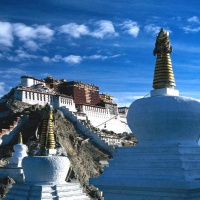- Home Page
- Fact Tours
Our sample tour itineraries of China and China travel packages are sorted by theme and available at competitive prices, you can browse what tours are right for you for your trip to China.
Popular China Tour Packages

Custom Tour Packages to China and Ask Our Experts for Free Enquiry !
- Coach Tours
- Destinations
Beijing, the capital of China. Its art treasures and universities have long made it a center of culture and art in China.
Beijing Top Attractions
Beijing City Tours
Shanghai, the cultural and economic center of East Asia. It renowned for its historical landmarks, the extensive and growing skyline.
Shanghai Top Attractions
Shanghai City Tours
Best China Tours with Shanghai
Xi'an, having held the position under several of the most important dynasties. It is the top destination to explore the facts of Chinese history.
Xi'an Top Attractions
Xi'an City Tours
Best China Tours with Xi'an
Huangshan boasts its culture, beautiful rivers, villages and mountains. It's home to 2 UNESCO World Heritage Sites and the Mecca of photographers.
Huangshan Top Attractions
Huangshan City Tours
Best China Tours with Huangshan
Sichuan is the cradle of the Shu culture, panda, mahjong, teahouse and spicy food. The province ranks first in China by number of UNESCO World Heritage Sites. It is called "the Heaven of Abundance".
Sichuan Top Attractions
Sichuan Tour Packages
Best China Tours with Sichuan
Yunnan, literally means the south of colorful clouds, due to its beautiful landscapes, mild climate and diverse ethnic cultures and traditions, is one of China's major tourist destinations.
Yunnan Top Attractions
Tibet, the nearest land to the sky, is known for its breathtaking landscape, splendid culture, art, buildings, and mysterious religions.
Tibet Top Attractions
Tibet Tour Packages
Best China Tours with Tibet
Explore the lost civilizations by riding a camel! Travel across the Gobi and the desert, and over the high mountains. Our Silk Road tours including different sections of the Silk Road in China.
Silk Road Top Attractions
Silk Road Tour Packages
Best China Tours with Silk Road
Guilin, an internationally-known historical and cultural city, has long been renowned for its unique karst scenery. Its vicinities are the paradise of hiking, caving, rafting, biking and countryside exploring.
Guilin Top Attractions
- China Facts
- China Hotels
- Travel Photos
Attractions
- Tibetan Funeral Forms
- Tibetan Monks and Lamas
- Religion Of Tibet
- Tibetan Butter Tea
- Tibet Museum
- Zhigongti Temple
- Tashilumpo Monastery
- Drepung Monastery
- New Palace of Panchen
- Yumbulagang Palace
- Samye Monastery
- Palkhor Monastery
- Sera Monastery
- Yarlung Zangbo River
- Gandan Monastery
- Midui Glacier
- Yamdrok Lake
- Nyainqentanglha Mountains
- Namjagbarwa Peak
- Ranwu Lake
- Karola Glacier
- Galong Temple
- Giant Cypress Forest
- Basum Tso Lake
- Segila Mountain
- Tibet Travel Permits
- Rongbuk Monastery
- Tibetan Drum
- Tibetan Folk Songs
- Tibetan Opera
- Lake Yamzho Yumco
- Yarlung Zangbo Grand Canyon
- Yangpachen
- Sakya Monastery
- Norbulingka
- Ramoche Temple
- Barkhor Street
- Mt. Everest Base Camp
- Jokhang Temple
- Namtso Lake
- Potala Palace
Potala Palace
Potala Palace in Lhasa is situated on Red Hill 3,700 meters above the sea level, was originally built by Tibetan (called Tubo in ancient China) King Songtsan Gambo in the 7th century for Tang Princess Wencheng. Potala features the essence of ancient Tibetan architectural art and houses many artifacts of the Tubo Kingdom.
The Potala Palace covers an area of 360,000 square meters, and measures 360 meters from the east to the west and 270 meters from the north to the south. Its main hall has 13 stories, 117 meters in height. The Potala architectural complex includes the palace halls, holy tower halls, Buddhist halls, sutra halls, lamas' chambers, and courtyards etc.
Travel the Potala Palace with China Fact Tours
It features a combination of the stone-and-wood Tibetan watchtowers and the Han Chinese palace halls with the traditional carving beams and pillars, golden roofs and sunk panels. Its courtyards and winding corridors were arranged to comport with the location. While the major part of the palace complex is highlighted, subordinate architectural groups form a jagged, interlocking pattern providing more space than one would expect. For hundreds of years, Potala Palace has been recognized a great achievement in the history of the world architecture.
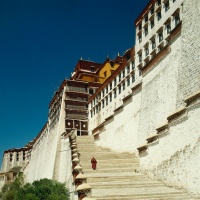 Legends have it that the Tubo King Songtsan Gambo, a devout Buddhist, often went to recite Buddhist scriptures and prayed by what he later named Potala Hill when he made the city of Lhasa his kingdom's capital. Potala is the Sanskrit pronunciation of Buddha's Mountain. In the Tibetan language, Potala means residence of the Goddess of Mercy.
Legends have it that the Tubo King Songtsan Gambo, a devout Buddhist, often went to recite Buddhist scriptures and prayed by what he later named Potala Hill when he made the city of Lhasa his kingdom's capital. Potala is the Sanskrit pronunciation of Buddha's Mountain. In the Tibetan language, Potala means residence of the Goddess of Mercy.
In 614 A.D. when he married Princess Wencheng of the Tang Dynasty (618-907), he had the Potala Palace built for her. The Potala Palace he built had nine stories, with 999 palace chambers and 1,000 halls specially built for Buddhist meditation in the hill. In the ensuing years, the Potala Palace suffered from wars, thunderbolts and fire. Only the Cave for the Prince of Dharma and the Main Hall, the Pagbalhakang, survived these devastating changes. The present Potala Palace was rebuilt after the 17th century.
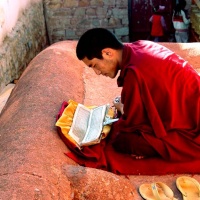 The main architecture of the Potala Palace is composed of the two parts: Places used by the Dalai Lama as his living chambers and for political activities; and holy stupas of the successive generations of Dalai Lamas and various Buddhist halls.
The main architecture of the Potala Palace is composed of the two parts: Places used by the Dalai Lama as his living chambers and for political activities; and holy stupas of the successive generations of Dalai Lamas and various Buddhist halls.
The first part is concentrated in the White Palace, built in 1645-1653. This part fans out from the original Hall of the Goddess of Mercy towards the east and west, encompassing groups of monastic halls with white walls hence the name the White Palace. The White Palace has seven stories. The fourth story, the Coqenxag or the Eastern Hall, covers an area of 717 square meters and is propped up by 38 large pillars.
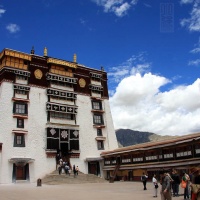 This is the most important Buddhist hall in the Potala Palace, and has witnessed many major religious and political activities, including the enthronement ceremony for the reincarnated soul boy of the Dalai Lama and the ceremony held when the Dalai Lama begins his reign at the age of 18. The fifth and sixth stories were used as the offices and living chambers of the Prince Regent. The seventh story was the Winter Palace of the Dalai Lama.
This is the most important Buddhist hall in the Potala Palace, and has witnessed many major religious and political activities, including the enthronement ceremony for the reincarnated soul boy of the Dalai Lama and the ceremony held when the Dalai Lama begins his reign at the age of 18. The fifth and sixth stories were used as the offices and living chambers of the Prince Regent. The seventh story was the Winter Palace of the Dalai Lama.
It is called the Sunlight Hall simply because the hall enjoys boundless sunlight through its spacious windows. The hall is furnished with gold basins, jade bowls, Buddhist paintings and many other treasures, accentuating the high position of the occupant. Outside the Sunlight Hall is a spacious balcony offering a bird's-eye view of the whole of Lhasa. In the distance are undulating mountain ranges, the beautiful Lhasa River, tracts of fields, tree-shaded villages and the glistening Jokhang Monastery.
The second part is concentrated in the Red Palace, occupies an area of 10,000 square meters, where the statues of Songtsan Gambor, Princess Wencheng and some thousands of Buddhist figures are placed for worshipping. When the Red Palace was built in 1690, the Qing Dynasty Emperor Kangxi sent some 100 artisans of the Han, Manchu and Mongolian nationalities to take part in the construction.
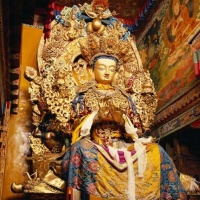 The majority of the Red Palace is taken up with various Buddhist halls and eight holy stupas containing the remains of the Dalai Lamas. The holy stupa for the 5th Dalai Lama is wrapped inside 110,000 taels of gold sheet (approximately equal to 143,000 ounces) and inlaid with 18,677 pearls and pieces of gems, coral, amber and agate. Sixipuncog, or the Western hall, is the largest hall in the Red Palace. The hall covers 725 square meters, and holds a plaque bearing an inscription by Emperor Qianlong of the Qing Dynasty.
The majority of the Red Palace is taken up with various Buddhist halls and eight holy stupas containing the remains of the Dalai Lamas. The holy stupa for the 5th Dalai Lama is wrapped inside 110,000 taels of gold sheet (approximately equal to 143,000 ounces) and inlaid with 18,677 pearls and pieces of gems, coral, amber and agate. Sixipuncog, or the Western hall, is the largest hall in the Red Palace. The hall covers 725 square meters, and holds a plaque bearing an inscription by Emperor Qianlong of the Qing Dynasty.
Inside the hall is the holy throne of the Dalai Lama and a pair of colored silk curtains granted by Emperor Kangxi of the Qing Dynasty. The Three-World Hall, which is the highest in the Red Palace, holds the Beijing-edition Dangyur which Emperor Yongzhen of the Qing Dynasty presented to the 7th Lalai Lama. The westernmost section of the Red Palace is the Hall of the Holy Stupa for the 13th Dalai Lama, built in 1933-1935. The hall, 14 meters high, contains a Mandala said to be made of 200,000 pearls. The Potala Palace is a treasure house of Tibetan art, the opulence of which reflects the enormous differences that existed between the nobles and the serfs and slaves, who made up 95 percent of the Tibetan population, in the old days.
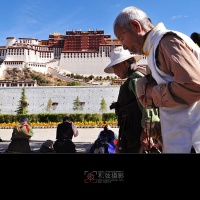 While the Red Palace is composed of the religious center and the Holy Stupa Memorial Hall, the White Palace features the living chambers and political center of the Dalai Lama. Both palaces indicate the social character of temporal and religious activities in old Tibet. The 5th Dalai Lama moved into the White Palace from the Zhaibung Monastery as soon as the former was built. He stayed there until his death. From then on all the successors of the Dalai Lama resided in the Potala Palace, from where they exercised political and religious power. This is why lamas and Tibetan Buddhists worship the Potala Palace and regard it as the holy land.
While the Red Palace is composed of the religious center and the Holy Stupa Memorial Hall, the White Palace features the living chambers and political center of the Dalai Lama. Both palaces indicate the social character of temporal and religious activities in old Tibet. The 5th Dalai Lama moved into the White Palace from the Zhaibung Monastery as soon as the former was built. He stayed there until his death. From then on all the successors of the Dalai Lama resided in the Potala Palace, from where they exercised political and religious power. This is why lamas and Tibetan Buddhists worship the Potala Palace and regard it as the holy land.
In addition, the Potala Palace has some subsidiary buildings including the Langjieza Chang, the Lama school, lamas' chambers, the eastern and the western courtyards, and some other buildings which were constructed at the foot of the Red Hill such as the Xuelao City, the Majikang of the former local government of Tibet, Xuebalie Kong, the old printer for Buddhist scriptures, ancient prison, old stables and the Dragon pool that located at the backyard of the palace.
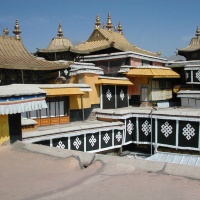 For over 300 years, the Potala Palace was the center from which Tibet's political and religious administration was run. It is now a museum of historical relics and arts and crafts, including 50,000 square meters of frescos featuring lifelike figures, which tell religious stories, display Tibetan customs and habits, and often contain biographies of historical and religious figures, and records of great historical events. The frescos record the expansion of the Potala Palace in history and Princess Wencheng's entry into Tibet in the 7th century. In the Western Hall, there is a wall of frescos which display the 5th Dalai Lama paying homage to the Qing Emperor Shunzhi in 1652. In the Hall for the Holy Stupa of the 13th Dalai Lama is a fresco recording the 13th Dalai Lama paying homage to Qing Emperor Guangxu and Empress Dowager Ci Xi in Beijing. The palace also boasts a huge collection of cultural relics and Buddhist classics, such as close to 1,000 Buddhist pagodas, about 10,000 statues of Buddha, numerous tangka paintings, pattra-leaf Sutra and Gangyur, as well as gold certificates of appointment, gold and jade seals of authority, which are the emperors of the Ming and Qing dynasties bestowed to the successive Dalai Lamas. These historical and cultural relics are witness to the fact that China is a country with many nationalities, including the Tibetan. Rich collections of woolen rugs, canopy, religious objects, curtains, silk fabrics, gold and silver utensils, chinaware, enamels and stone artifacts often provoke wonder and amazement in visitors.
For over 300 years, the Potala Palace was the center from which Tibet's political and religious administration was run. It is now a museum of historical relics and arts and crafts, including 50,000 square meters of frescos featuring lifelike figures, which tell religious stories, display Tibetan customs and habits, and often contain biographies of historical and religious figures, and records of great historical events. The frescos record the expansion of the Potala Palace in history and Princess Wencheng's entry into Tibet in the 7th century. In the Western Hall, there is a wall of frescos which display the 5th Dalai Lama paying homage to the Qing Emperor Shunzhi in 1652. In the Hall for the Holy Stupa of the 13th Dalai Lama is a fresco recording the 13th Dalai Lama paying homage to Qing Emperor Guangxu and Empress Dowager Ci Xi in Beijing. The palace also boasts a huge collection of cultural relics and Buddhist classics, such as close to 1,000 Buddhist pagodas, about 10,000 statues of Buddha, numerous tangka paintings, pattra-leaf Sutra and Gangyur, as well as gold certificates of appointment, gold and jade seals of authority, which are the emperors of the Ming and Qing dynasties bestowed to the successive Dalai Lamas. These historical and cultural relics are witness to the fact that China is a country with many nationalities, including the Tibetan. Rich collections of woolen rugs, canopy, religious objects, curtains, silk fabrics, gold and silver utensils, chinaware, enamels and stone artifacts often provoke wonder and amazement in visitors.
 The Chinese government has a high regard to protect the Potala Palace. In 1961, the State Council made the Potala Palace one of the major cultural relics subject to state protection, and earmarked a huge amount of funding for its repair. The Potala Palace, however, failed to experience a thorough repair in the 300-odd years after its reconstruction. Many hidden dangers existed. The State Council decided in 1989 to renovate it on a large scale. This marked the largest repair project undertaken since the founding of the People's Republic of China in 1949. The repair of the Potala Palace proceeded strictly in accordance with the traditions of the Tibetan race and the rituals of Tibetan Buddhism. The project was successfully completed in September 1994 at a cost of 53 million yuan (RMB). Potala Palace was listed into the World Heritage Sites by the UNESCO in the same year.
The Chinese government has a high regard to protect the Potala Palace. In 1961, the State Council made the Potala Palace one of the major cultural relics subject to state protection, and earmarked a huge amount of funding for its repair. The Potala Palace, however, failed to experience a thorough repair in the 300-odd years after its reconstruction. Many hidden dangers existed. The State Council decided in 1989 to renovate it on a large scale. This marked the largest repair project undertaken since the founding of the People's Republic of China in 1949. The repair of the Potala Palace proceeded strictly in accordance with the traditions of the Tibetan race and the rituals of Tibetan Buddhism. The project was successfully completed in September 1994 at a cost of 53 million yuan (RMB). Potala Palace was listed into the World Heritage Sites by the UNESCO in the same year.
The Potala Palace has become the world famous Buddhist holy land. In the eyes of every Tibetan it is the sacred place and the end of the rainbow. Every day, many pilgrims from all areas of Tibet are seen going forth to the Potala Palace. In the great events and activities, believers of all ethnic groups collect in the gate of the palace dancing and singing to celebrate. The whole palace is in a festal atmosphere.
Questions & Comments
Home | About Us | Partnerships | Terms & Conditions | Privacy & Security | Payment Guide | Resource Links| Sitemap
Email: contact@chinafacttours.com, Tel: +86-773-3810160, Fax: (+86) 773-3810333
Copyright © 2008-2020 China Fact Tours. All rights reserved
![]()










